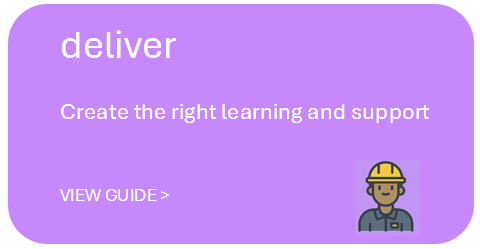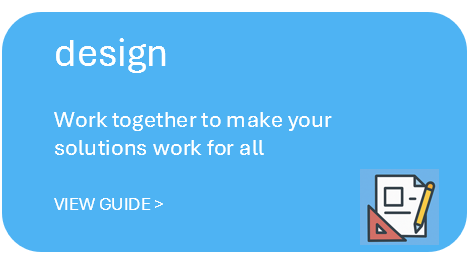Introduction
Degree-Level Apprenticeships only succeed when they are deliberately designed, rather than retrofitted from or tacked onto existing degrees, internships, or work placements.
Designing a DLA means shaping an experience where:
Learning is integrated across work and study—not delivered in silos
Employer and provider responsibilities are clear, balanced, and practical
Learners are set up to succeed, with support available in both settings
Assessment reflects real-world capability and academic standards
Delivery is flexible, responsive, and inclusive
This phase is where principles become practice.
What this involves
The Design phase includes:
Mapping the DLA learning journey across both the job and the qualification
Clarifying responsibilities for delivery, support, and supervision
Embedding work-integrated learning and assessment throughout the degree
Creating learner-centric structures
Finalising delivery logistics such as enrolment, funding, pacing, and modes
Good design doesn’t mean getting everything perfect upfront, but it does mean co-designing with, not just for, learners and employers.
Employers
Your role: Help define the real work tasks, workplace capabilities, and supervisory structures that make the apprenticeship meaningful and productive.
What to contribute:
Job-role mapping: What roles and duties will the apprentice actually perform? Think about whether the apprentice is new to your business or the industry, or might be an existing employee with more experience?
Supervision planning: Who will guide the apprentice? What support do they need to succeed as mentors or team leads?
Work-integrated tasks: What workplace activities can be linked to specific learning outcomes in the degree?
Assessment input: How can you contribute through tasks like verifying that the work is the apprentice’s own or providing workplace observations, assessment or feedback?
Key outcome: A clear, structured plan for how the workplace supports the apprentice’s learning aligned with the qualification and realistic for the business.
Tools for you
Employer-provider role matrix
Tertiary providers
Your role: Take the lead in designing a qualification structure that integrates work-based learning, supports diverse learners, and maintains academic integrity.
What to contribute
Curriculum integration: Align workplace activities with learning outcomes, course modules, and assessment milestones
Blended and flexible delivery: Offer modes that work for employed learners (e.g. online, block courses, evening sessions)
Recognition of prior learning: Build in pathways for learners with existing credentials or experience
Support systems: Coordinate with employers to ensure pastoral, academic, and cultural support are tailored to work-based learners
Admissions: Operationalise dual-admissions where employer and provider jointly approve candidates.
Key output: A documented qualification and programme structure that embeds the DLA model across curriculum, delivery, assessment, enrolment, and learner support systems and meets accreditation requirements.
Tools for you
Models of work-integrated delivery
Industry Skills Boards, Professional Bodies, and Industry Associations
Your role: Ensure the qualification and workplace experience align with occupational standards, registration requirements, and long-term workforce development goals.
What to contribute
Occupation standards alignment: Confirm the DLA programme reflects the technical, ethical, and professional expectations of the role
Qualification suitability: Validate whether the degree is fit-for-purpose, or identify adaptations needed
Registration guidance: Where applicable, ensure the programme can lead to professional registration or licensure
Workforce equity and diversity: Promote inclusive design that supports underrepresented groups in the profession
Direct contributions: What roles can professional bodies or industry associations play?
Key output: Confidence that the DLA will produce competent, recognised, and employable graduates within the profession or industry.
Tools for you
Roles of professional bodies
Learners and Whānau
Your role: Bring lived experience and learner voice into the design process to ensure the DLA is accessible, realistic, and empowering.
What to align:
Lived experience insights: What supports did you need (or wish you had) to stay engaged and succeed?
Feedback on pacing and workload: Is the proposed rhythm of study + work sustainable?
Equity prompts: Are Māori, Pacific, women, and underserved learners being considered in design decisions?
Expectations clarity: Is it clear what you can expect from your employer and your provider?
Key output: A programme designed with not just for learners, including practical support structures and clear communication about rights, responsibilities, and expectations.
Tools for you
Learner experience flowchart
Tools and Templates
You can use the following tools (available in the toolkit) to support alignment conversations:
Roles of professional bodies
Models of work-integrated delivery
Employer-provider role matrix
Learner experience flowchart
What comes next?
Once the programme has been designed and responsibilities are clear, the partnership can move into Delivery operationalising the DLA model, inducting apprentices, and ensuring systems are in place to support them across both learning environments.
Design is where the foundation becomes a real plan. Get it right, and the delivery phase becomes not just manageable, but powerful.
The DLA toolkit
Guidelines
-

Guide for employers
An introduction to degree-level apprenticeships for employers
-

Guide for apprentices
An introduction to degree-level apprenticeships for learners
-

Guide for TEOs
An introduction to degree-level apprenticeships for tertiary education organisations











